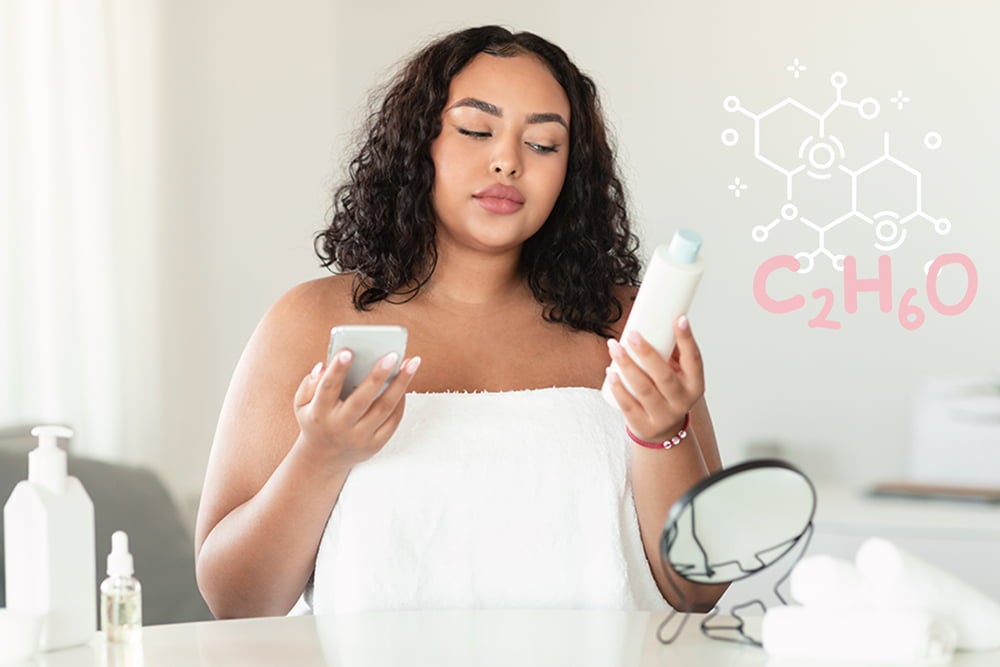Alcohol In Cosmetic Products: Harmful or Beneficial?
The alcohol component found in cosmetic products are often regarded very sceptically. Is alcohol in cosmetics really harmful or does it fulfil a more important function?
What is Alcohol?
Alcohol is the umbrella term for a group of liquids. Today, it is most commonly referred to as ethanol and is obtained through sugar or biomass fermentation.
Alcohol Properties in Cosmetics
Alcohol can be found in a wide range of cosmetic products such as body lotions, after shave or fragrances, the reason being that it
- has an antibacterial effect.
- dissolves fat.
- serves as a preservative and guards against microbial contamination.
- has anti-inflammatory properties.
- has a deodorizing effect.
- acts as a solvent to obtain water-insoluble substances from plants.
Is Alcohol Harmful For Our Skin?
Ethanol in large quantities destroys the skin's sebum layer. It has hygroscopic properties, which means that it withdraws water from the skin making it dry and cracked. The effect is diminished when mixed with water.
Formulations that contain ethanol can quickly lead to a vicious circle. One uses a cream that was created for dry skin. The cream dries the skin even more because it contains ethanol. This leads to using more of the cream since the skin has become drier, which dries the skin even more...
Whether or not alcohol is bad for the skin depends on the type of alcohol used and in which concentration.
When the alcohol content is 5% or less this will not have a bad effect on the skin because it evaporates completely while the product is applied to the skin, which eliminates the risk of skin becoming drier. It unfolds its preserving properties within the formulation to protect against microbial contamination. In comparison, using chemical preservatives are worse for the skin because parabens remain on the skin and are then absorbed by the body.
"Good" vs. "Bad" Alcohol
As previously mentioned, there are various kinds of alcohol. Ethanol is categorized as a bad alcohol because it damages and dries the skin. Oftentimes, denatured alcohol is mix with phthalates. This is problematic because high concentrations may lead to infertility and diabetes.
Fatty alcohol is categorized as a "good" alcohol and is obtained plant fatty acids. They are non-toxic, well tolerated by the skin and biodegradable. This type of alcohol has conditioning and moisturizing properties while relieving any irritations. An example would be fatty alcohol derived from coconuts. These substances are used in the natural cosmetics industry as emollients or thickeners. The only disadvantage is that they cannot be mixed with water. Here are a few that fall into this category: Behenyl Alcohol, Cetearyl Alcohol, Cetyl Alcohol, Lanolin Alcohol and Stearyl Alcohol.
Conclusion
It is always best to read product labels. Determining which alcohol is used and what the concentration is the first step. If alcohol is listed as the second ingredient, it means that the product contains a higher alcohol concentration and is not suitable for people with sensitive skin.
Note: Cosmetics labelled as "alcohol-free" does not necessarily mean without alcohol. According to European cosmetics regulations, products may be labelled "alcohol-free" if they do not contain "bad" alcohol, i.e. fatty alcohol, that causes dryness.
Related products
-
 4.4 (179)
4.4 (179)La Saponaria Organic Witch Hazel Hydrolate, 100 ml
- For impure, irritated & sensitive skin
- Astringent & regenerating
- Relieves the skin
CHF 5.60 (CHF 56.00 / l)Delivery by April 25
-
 4.3 (21)
4.3 (21)Eliah Sahil Organic Curcuma Tooth Oil, 100 ml
- Strengthening & purifying properties
- Fresh breath
- Easy to use
CHF 12.80 (CHF 128.00 / l)Delivery by April 25
-
 4.1 (27)
4.1 (27)ANARKHIA KAT Styling Gel, 200 ml
- For straight & curly hair
- Moulds & hydrates
- Stimulates hair elasticity
CHF 14.15 (CHF 70.75 / l)Delivery by April 25
-
 4.6 (231)
4.6 (231)Dr. Bronner's Organic Lavender Hand Sanitizer Spray, 60 ml
- Suitable for all skin types
- Reliable purifying action
- Suitable for surfaces
CHF 7.60 (CHF 126.67 / l)Delivery by April 25


